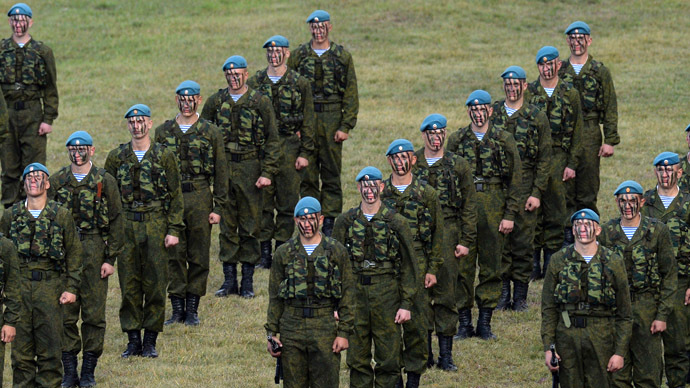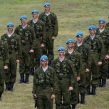
Russian Military Technology Post-Crimea
Publication: Eurasia Daily Monitor Volume: 11 Issue: 94
By:

Russian military operations in Crimea have increased the prestige of serving in the Armed Forces, which has been a welcome boost to Moscow’s on-going efforts to recruit larger numbers of contract personnel. This drive to strengthen military manpower is accompanied by considerations of the technological needs of re-equipping and modernizing the force structures. Thus, due to inherent problems within the Russian defense industry, compounded by existing international sanctions and the prospect of more to follow, the Kremlin is being compelled to find new ways to support military modernization; but it is not proving easy to reconcile such contradictions (https://www.gazeta.ru/politics/2014/05/18_a_6038377.shtml).
Confirmation that military service received a boost after the operation in Crimea came on the streets of cities in which the elite Airborne Forces (VDV) are located. The Ministry of Defense’s latest efforts to promote contract service involves setting up public recruitment points in the central squares of Tula, Pskov, Novorossiysk, and Ivanovo—all cities that host VDV units. The defense ministry, in cooperation with the local authorities, plans a series of shows in the four cities in which VDV personnel will demonstrate hand-to-hand combat skills. The spectacles will also feature the display of military hardware and equipment, as well as live concerts and photo exhibitions on the history of the VDV. These plans represent a continuation of wider experiments aimed at recruiting directly from the public rather than by persuading conscripts to sign contracts (Ekho Moskvy, May 13).
While such developments will indeed serve to generate fresh interest in professional service under contract, there are also setbacks linked to financial constraints. For example, the widely vaunted creation of “Information Troops” has been postponed due to high costs. Earlier, it was reported that the Information Troops would emerge in the Russian military by the end of 2013. They would have constituted a separate branch of troops, the main task of which being to monitor and process data coming in from abroad and to fight cyber threats. But more recently, defense ministry sources told RIA Novosti, “There is no and there will be no such structure. This information has been in the air, but it is too costly,” adding that combating cyber threats is a priority task and that a scaled down structure could be established in the future (RIA Novosti, May 12).
Undeterred by this setback on innovation within the Armed Forces structures, the defense ministry plans to abolish the Aerospace Defense Forces (VKO), created in December 2010, and replace this by December 2014 with a structure merged with the Air Force and known more simply as Aerospace Defense (https://itar-tass.com/politika/1195851). Such structural experiments are sure to continue, but the existence of a technologically demanding structure will add further pressure on the domestic defense industry.
While the challenge of instituting a new branch of service based on technically proficient troops has been shelved, this pales in comparison with the longer-term tasks of rearming the Russian military. Faced with a sanctions regime already targeting the high-technology sector, the Kremlin is clearly concerned about such problems. On May 14, President Vladimir Putin chaired a meeting on the issue of defense procurement and adopted a grim line. He noted, “We have new circumstances to address now—the need to replace imports. I asked the government two or three weeks ago to have ready for today an overall analysis of everything related to this area and to calculate the additional funds needed and the timeframe in which we can resolve these new tasks” (kremlin.ru, May 14).
These themes concerning costs and encouraging the defense industry in tough times are also present in the work of leading procurement specialists. Major-General (retired) Vasily Burenok, the president of the Russian Academy of Missile and Artillery Sciences, delivered a paper to the Academy on April 18 reflecting on-going work on Russian military-technical policy. Burenok’s subsequent article in Voyenno Promyshlennyy Kuryer is itself important. However, it has added value due to the inclusion of his Academy on December 19, 2013, among the organizations working on the development of military-technical policy. Burenok led research on the further development of science and technology to support defense and security to 2013, specifically examining aviation weapons and equipment (https://www.vpk-news.ru/articles/20234).
Burenok explains that his Academy conducted its own threat assessment. He refers to “relentless” efforts by the West to increase its influence in the world and in close proximity to Russia’s borders. Burenok then detailed the main threats to Russia’s security as follows:
• The creation of a full-fledged United States ballistic missile defense system and the basic elements of missile defense in China;
• Adoption by the US military of hypersonic cruise missiles by 2025;
• The creation of NATO high-tech kinetic weapons, laser systems, precision board control means of destruction, combined weapons guidance systems, precision strap down inertial navigation systems, new explosives, etc.;
• Intensive development in the advanced countries of space technology, including on the basis of mini- and nano-satellites of various functions (combat, reconnaissance, electronic warfare);
• Expanding the use of information warfare and cyber operations against the Russian Federation;
• Development and implementation of sixth-generation warfare technologies, including technical solutions based on nano-technology (technology of alternative energy sources, etc.), biotechnology (chemical and information technology, robotics, genetic engineering methods, etc.), information and cognitive technologies (technologies related to “biological element base” solutions and weakly formalized creative tasks);
• Creation and actual replacement of traditional weapons systems and unmanned aerial vehicles (UAV) for various purposes, terrestrial and marine robotic systems developed on the basis of fundamentally new technologies, autonomous energy sources, artificial intelligence, and the ability to independently perform combat tasks in any environment.
Burenok is in no doubt about the identity of Russia’s “hypothetical opponent” behind almost all of these threats: the United States. However, he admits that Russia lacks the capacity to develop forces and equip them to respond in parity. Therefore, he reiterates the idea that Moscow develop asymmetric responses (https://www.vpk-news.ru/articles/20234). Burenok understands that the formation of an “innovative army” in Russia is no easy task, and he admits the modernization will be arduous. Nonetheless, he is clear about the basis of innovation strategy rooted in equipping the Armed Forces with high-tech weaponry and “a new generation of weapons” based on “new physical principles,” perfecting the intelligence system under a single command, establishing automated command and control, and building a force to combat an adversary that uses non-contact and information warfare. Indeed, the identification of the US as the potential enemy, coupled with the post–Crimean annexation sanctions, may serve as stimuli to promote internal military transformation.




